Sea salt, table salt, rock salt…
What kind of salt is best for fermentation? Explore this question with a visit to the solar salt pans of Aveiro, Portugal
People often ask me what the best type of salt for fermentation is. The simple answer is to make sure the salt you use does not have iodine added to it. Added iodine can inhibit fermentation, but I have yet to see naturally occurring iodine in unrefined salts cause an issue. (This salt post is about why salt is needed in fermentation.)
From there you can base your fermentation salt decision on what is important to you. You could choose by production method (brine evaporation, white salt solution mining, or rock salt mining), by taste, flake size, cost, or geography (artisan salt works closest to you).
Today I want to share what I learned in late April when I had the opportunity to visit my first salina (salt pans for brine evaporation) Aveiro, Portugal. Aveiro is an easy day trip by train from Porto. Well, easy for most, for some reason my daughter and I struggled with the ticketing machine in the train station and ended up having a few conversations with conductors when we handed them the (unbeknownst to us) wrong tickets. And an extra stop, after we were kicked off the fast train and told to wait for the next slow train.
Aveiro is situated on the Aveiro lagoon (Ria de Aveiro) where the Vouga River lazily meets the Atlantic Ocean. The river fans out creating a complex ecosystem of estuary and lagoon. What is the difference? In an estuary, the water moves quickly through this area of fresh water mixing with salt water. In a lagoon, it is the same mixing but the water is slow-moving. In both, the water fluctuates with the tide and as it is with nature these waters at the edge, no longer river, and not quite ocean, are where life is abundant. Much of this area is one of Europe’s last remaining intact coastal marshlands.
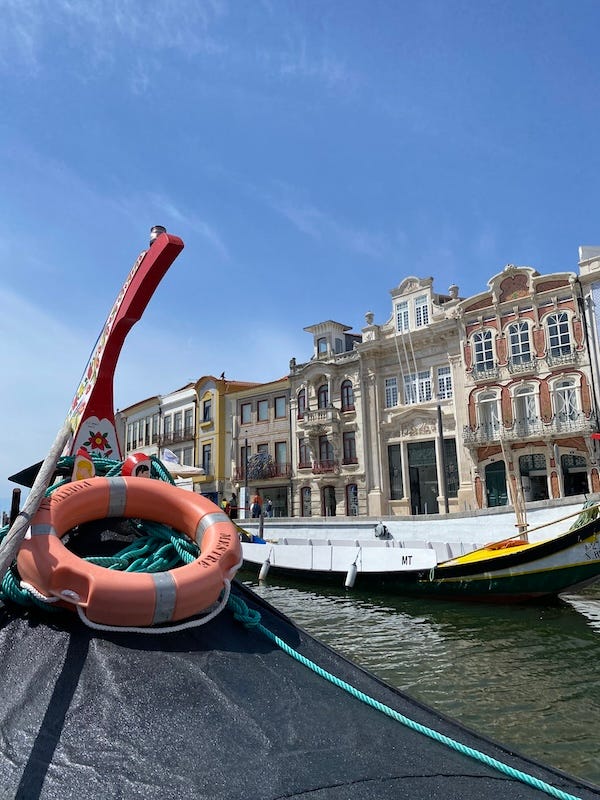
Because this town is located in a salt marsh ecosystem water is part of life of the town. Similar in form and bright color to Venice’s gondolas this region’s traditional boats are moliceiros. These flatbottomed boats were used to collect seedweed ("moliço" in Portuguese) to fertilize farm fields. They also carried salt and other goods from place to place. The town was both an ancient port and a salt-producing region. Romans saw this as an economically important area of the empire. Must have been very valuable given they paid part of their soldiers in salt…(or, so we are told. Some people argue there isn’t a ton of evidence to support that.)
Salinas are ecosystems that are not natural per se but should be seen as salt wetlands that are integrated with ancient practices of human management. Like fruit trees that need our care and pruning, a salt wetland is similar in that it has become dependent on certain care. For example, part of what is good for birds in these wetlands is that the water levels are managed in the salinas. When done right, this keeps the pools from drying out and the nests from flooding out.
There is ecological value in a salina wetland. It is different than a freshwater wetland, but the biomass and species diversity in a salina wetland can be just as significant as in a freshwater wetland. Current research suggests these artisanal salt pans also sequester carbon.
Microalgae, halophyte plants and halophilic microbes live in saline environments. This life of the salt pan (microbiome) must tolerate tremendously harsh conditions, not only the salt stress but also extreme fluctuation in moisture from flood to desiccation. The dikes, embankments, and walkways are also home to plants that play an important role in cleaning the water of pollutants. These plants have salt glands to remove salt and prevent the uptake of high salt concentrations.
Common plant residents include Salicornia ramosissima (a succulent common name glasswort), Batis maritime (saltwort, a long-lived perennial succulent), Halimione portulacoides (sea purslane, an evergreen shrub), and Juncus maritimus (sea rush). The rushes were used for centuries to line the floors of haystacks and to cover piles of salt.
Active salt marshes are rich in nutrients. They also are rich in biodiversity and serve as feeding and nesting grounds for shorebirds, such as Long-legged (Himantopus himantopus), Common Sandpiper (Calidris alpina), Pied Plover ( Charadrius alexandrinus). Like any wetland, the presence or absence of birds is an indicator of health. The birds feed on insects, small crustaceans, tiny fish, and plants that are found in the mud at the bottom of the salt pans.
At this point, the decline of production in salinas is of ecological concern. When they are abandoned the changes in water control cause huge changes and often the wetland, its flora, fauna, and biological systems are lost to the increased water levels.
It feels like harvesting salt, a basic human need, in a way that can coexist with nature is a good thing.
A little historical context
Regardless, before refrigeration, salt was extremely valuable for preserving food—especially meat and fish. Salt combined with either dehydration or fermentation and sometimes both is what kept people fed in lean times. Sea salt has been a solar and wind-powered process in areas with favorable conditions for thousands of years—there is evidence of Early Neolithic salt pans across the planet. And from most accounts these areas were wealthy.
But let’s get back to Ria de Aveiro. This area is situated in area that experiences hot, dry winds during the summer making it perfect for solar salt production. This technology was introduced in Portugal by the Phoenicians in the 9th century BCE. This was around the time the Romans were utilizing the salt pans. Their occupation lasted until 711 BCE when Moors invaded.
The Moors continued to be in charge until the 11th century when the area became a playground for Portuguese royalty. I can only try to imagine how stunning the natural beauty of the area must have been pre-industrialization. The area is still known for the birds. (Our guide said the flamingos had just started migrating in that week.) I was delighted to see storks in their nests—something we just don’t have in Oregon.
By 1178 the area was providing salt for all of Portugal and exporting large amounts to the rest o Europe, where it was regarded as a quality product. In the 16th century, a huge storm changed the landscape and blocked the water flow significantly. This water stagnation caused the huge problems for production and the industry declined. (From 500 salinas in the 10th century to 170 by the 17th century, oh and there are 2 now. More on that soon.) In 1808 an artificial inlet was begun and by 1815 a system of four canals was built to create dry ground and waterways for transport. These canals steered the town’s development and modern identity. These canals sent the salt production numbers back up (as recently as 1970 there were 270 salinas) but by the mid-20th they were declining again.
As humans careened into an age of processed food preservation traditional salt production declined in Portugal and other parts of the world which is ironic in that so much of our processed foods contain way too much salt. The first blow to Portuguese saliculture was tinned fish, introduced to the world in 1840. The second hit to Portuguese saliculture was refrigeration, which as most of you know, canning and cooling also caused people across the planet to turn their back on fermented foods as well.
But for the Aveiro salinas new food technologies are only part of the story. Other factors include pond walls destroyed by ripples from motorized boats, the collapse of the also ancient cod fishery, and pollution from pulp mills upstream. (Pollution is another rabbit hole and complicating factor in sea salt which I promise to write about.) The salinas might have winked out altogether but Aveiro had a bit of what might be called a rebirth, or in more modern terms, rebranding. Until 2003 The canals were at the mercy of the tide. This meant when the tides were high all the homes needed to put up boards along their doors so that the brackish water didn’t flow in. Conversely, on low tides, the water would (literally) pull out of town and the natural mud flats were exposed to oxygen. And as it is with microbes and oxygen when this happened Aveiro was treated to that special smell of anaerobic getting an infusion of oxygen. Fermentation you could say. What changed in 2003? The canal got locks. Now the water is managed following the tides to keep, the now stagnant water, fresh while maintaining a consistent water level. No more smell and no more Aveiro as the butt of jokes about the gaseous smell that emanates from that region of the body.
It was when this happened that the town was able to capitalize on the charm of its canals, boats (moliceiros), whimsical art nouveau architecture, and artisan salt making. Current efforts to reclaim the salinas in Aveiro are concentrated on developing aquaculture in the salt pans. However, there are two salinas maintained and operated in the ancient way by people whose families have done this work for centuries. One is owned by the University of Aveiro. The second is the one we visited Troncalhada Salina, belonging to the city of Aveiro. It is a working salina, an open-air museum, and in the summer a spa. Yes, you can sink your body in the mineralized salt mud, and yes, I was about 6 weeks too early to do that. 🙁
How a salina works
A salina is a connected series of shallow ponds built on an imperceptible incline for gravity to keep the flow slow and steady from pond to pond. There is a high surface-to-water ratio for optimal evaporation. Seawater flows through becoming more and more concentrated until in the last pond the salt crystallizes.
It is important to note that traditional salt works have ethnological significance. We were told on our tour that the ways of production—from the equipment used to the working and social structure of the people employed has remained virtually unchanged. During the season the work takes place from sunrise to sunset and in the off-season the workers take jobs elsewhere. It is the Marnoto (salt worker) that runs the salina. Families worked in the pans together. The women who helped at the pans are called Salineiras (salt ladies) Their job, in the past, this part has changed, was to move the salt (from the salt pans to boats and boats to warehouse) in wicker baskets that they carried on their heads. These baskets weighed around 50 kilograms—that’s around 110 pounds.
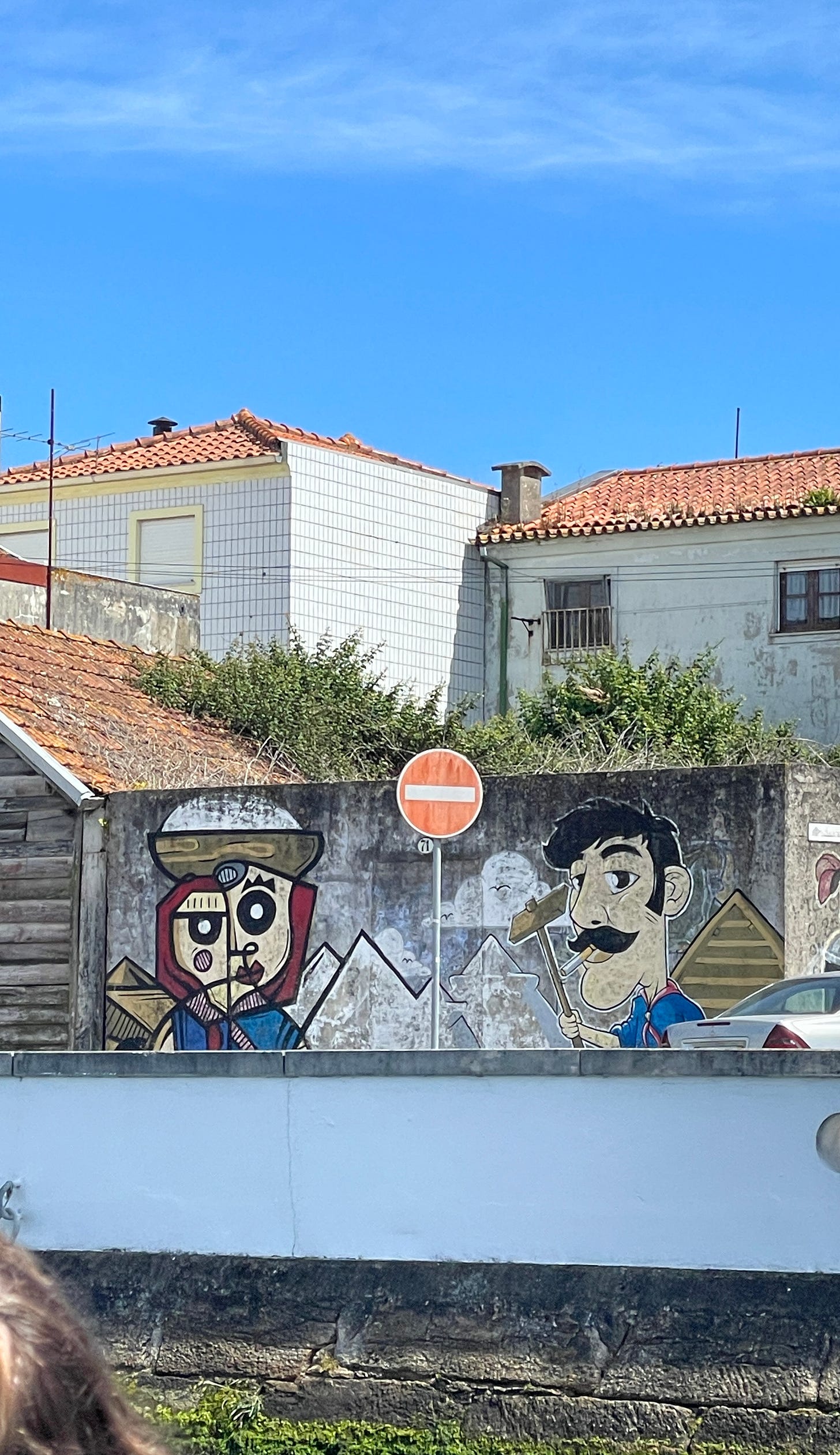
Salt harvesting is seasonal. The salt season opens in March with cleaning of the salt pans. This continues into May and is what we saw. The water that accumulates over the winter is drained. Sludge and algae are removed. The walls and pathways are repaired.
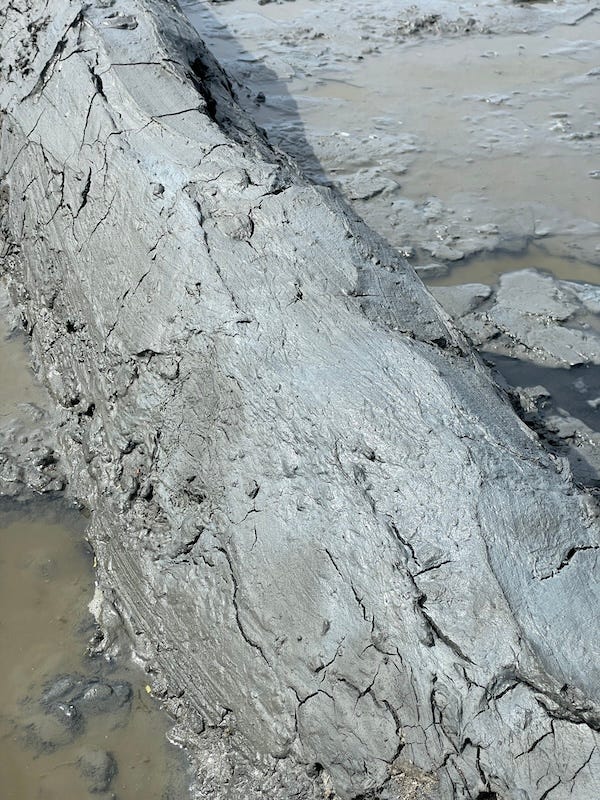
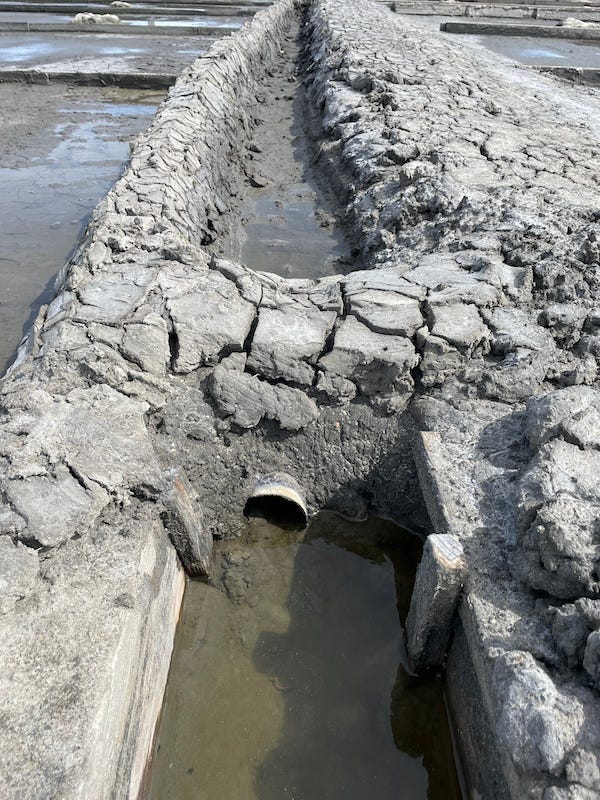
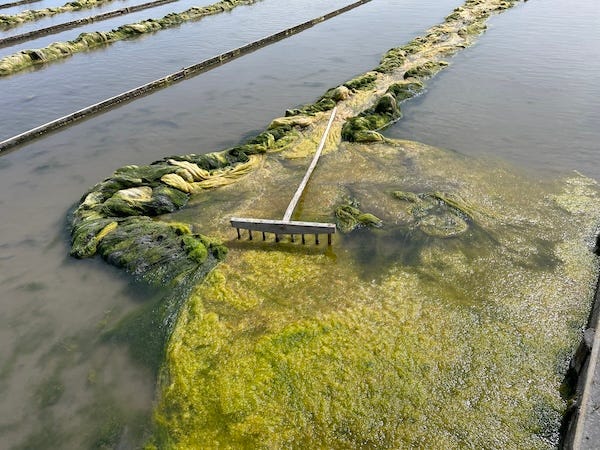
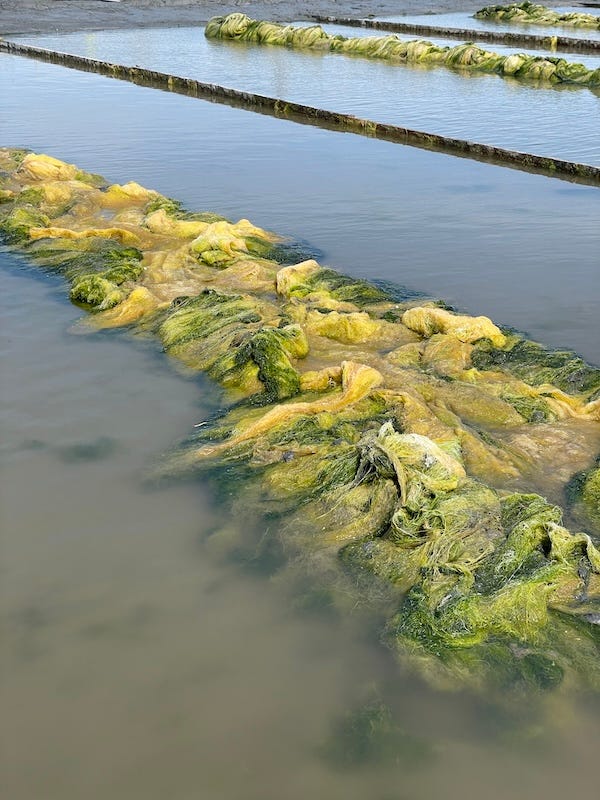
From May through July the soil is cured. This is done by soaking the soil with water and then allowing it to dry out while it is compressed and smoothed. This creates an impermeable surface for crystallization and salt formation.
Production begins when the sea water enters the pans for the first time called botadella. During the season, which officially ends September 8, it takes about 3 days for the water to move through the system for each harvest.
The system is generally not large, the one we were looking at I would estimate to be around 10 to 15 acres. It had several compartments. The first, largest and deepest are the supply ponds (viveiro and algibés). They are filled by seawater during the spring high tides that water through the inlet channel.
The water is then moved through narrow hand-dug ditches that are managed with wooden sluices that are filled with mud to close. Next stop is the evaporation ponds which take up the bulk of the area. There is a series of these ponds (in order caldeiros, sobre-cabeceiras, talhos and cabeceiras) that feed the crystallizer ponds. In Aveiro, there are two types of crystallizer ponds; condensers (omeios de cima) and crystallizers (meios de baixo). These two types of ponds were created to achieve the purest possible sodium chloride. As it crystallizes the water sometimes has an orange hue due to the microalgae. Which I learned is a source of natural Beta-carotene, and a sign told me it is responsible for the odor attributed to Aveiro salt—an odor of violets. I really want to smell violets in the salt I bought…but alas I cannot.
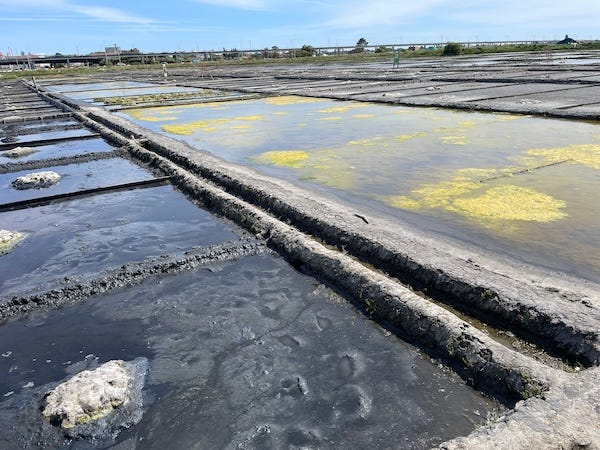
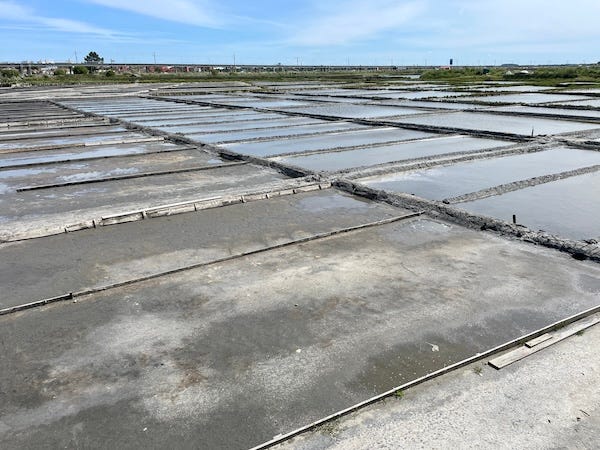
In many artisanal salinas the salt is condensed on the floor of the crystallizers. When the last of the water has evaporated the compacted salt is broken and washed with brine. Care is taken so that no sediment is mixed into the salt. Then the salt is piled up next to the crystallizer ponds and let dry. Once fully dry the dusty top layer is removed and the rest is stored.
In Aveiro, they also produce fleur de sel (flower of salt). This is salt harvest from the sodium chloride and traces of other salts that form on the top of the water when the conditions are right. It does not form in heavy wind or high humidity. This suspended salt is collected once or twice a day.
In September when the harvest season has ended the entire area is flooded and will remain that way until the cycle begins again in March.
This letter started with the question, what salt is best for fermentation?
In this virtual visit I have taken you to one place that practices solar salt production, you can see there are compelling ecological reasons to choose evaporated sea salt. And that, this choice isn’t straightforward in this messy world we inhabit and therefore can feel like a complicated decision.
I don’t have the answer.
For me, the answer to not use refined industrialized salt is easy. From there it gets fuzzy. When we produced fermented vegetables commercially it was also based on what was affordable in bulk that helped us make the highest quality product with the best flavor. We used Redmond Real Salt, a rock salt mined from an ancient seabed in Utah. It is a mineral-rich pink salt and much more local to us in Oregon than Himalayan pink salt. When I found out most sea salt has been found to contain microplastics, not wanting to consume them, I was even more committed to rock salts. This salt has been my preferred fermentation salt up until recently.
However, artisanal solar salt production is much lighter on a landscape than mining where enormous machines go through networks of tunnels blasting and cutting through rock. I still love Redmond salt, but I have started to think about how salt is made and its impact as a swaying factor. The problem of microplastics or toxins in sea salt is also location based. If you are concerned ask the maker and do a little research some are much cleaner than others.
Microplastic is a problem of our time. I learned that it is not just salt, plastics are found even our fruits and vegetables. They absorb the plastic through their roots just as some of the microplastic we might ingest ends up in our bodies through our gut lining. I accept that for myself microplastics cannot be fully avoided. And perhaps believing that microbes are truly our hope. Studies are showing the enzymes produced in fermentation can break down, mitigate, or weaken heavy metals and other chemicals in our vegetables. So, maybe…fermentation solves some of the downsides of solar-evaporated sea salt.
I used to try too hard to do everything right—which wasn’t good for anybody. Now I have to believe that the intention in doing my best is all I can do.
🐇🕳️
Writing this missive took me down more rabbit holes than I can count. I have a few more posts in mind around salt for paid subscribers. In order not to overwhelm I will share a few studies and my two favorite salt books.
While I don’t dive into these studies today, someday I will, I don’t want to leave you without anything to back up this carrot about fermentation and detoxification.
Microbial Detoxification of Residual Pesticides in Fermented Foods: Current Status and Prospects
Besides physical detoxification methods, a very successful and promising approach is fermentation by natural microflora in foods or by purposefully added probiotic strains. Detoxification mechanisms include enzymatic hydrolysis or oxidation of pesticides, which are degraded to less poisonous products, and intermediate metabolites have been demonstrated in some scientific publications by analysis with various analytical methods. In most cases, however, the exact metabolic pathway of degradation by the strains in food has not been elucidated and requires further research in the future.
Armenova N, Tsigoriyna L, Arsov A, Petrov K, Petrova P. Microbial Detoxification of Residual Pesticides in Fermented Foods: Current Status and Prospects. Foods. 2023 Mar 9;12(6):1163. doi: 10.3390/foods12061163. PMID: 36981090; PMCID: PMC10048192.
All fermented vegetables were characterized by lower levels of heavy metals, i.e. Cu, Pb, and Cd. Despite the relative loss of some nutrients and bioactive compounds, the physical and chemical changes induced by the fermentation process provided vegetables with new functionalities, e.g. probiotic character and durability.
Kiczorowski P, Kiczorowska B, Samolińska W, Szmigielski M, Winiarska-Mieczan A. Effect of fermentation of chosen vegetables on the nutrient, mineral, and biocomponent profile in human and animal nutrition. Sci Rep. 2022 Aug 4;12(1):13422. doi: 10.1038/s41598-022-17782-z. PMID: 35927577; PMCID: PMC9352655.
For those that love all things microbes…
This study looked at soil core samples from a saltpan on the Mississippi Gulf coast. The Saltpan Microbiome Is Structured by Sediment Depth and Minimally Influenced by Variable Hydration
The saltpan microbiome hosts multiple extremophilic taxa and an inferred metagenome revealed surprisingly high rates of energetic and nutrient cycling pathways, even when compared with adjacent brackish and fresh marsh.
Weingarten EA, Lawson LA, Jackson CR. The Saltpan Microbiome is Structured by Sediment Depth and Minimally Influenced by Variable Hydration. Microorganisms. 2020 Apr 8;8(4):538. doi: 10.3390/microorganisms8040538. PMID: 32276533; PMCID: PMC7232383.
Bacterial diversity and community structure of salt pans from Goa, India
Salt pans being polyextremophilic, are dynamic habitats of the resident bacteria potentially capable of tolerating extremely stressful environmental factors, i.e., high salinity (30–450 PSU), high alkalinity (pH 7.6–8.25) and fluctuating temperatures (20°C – 45°C)… These hypersaline natives are resistant to osmotic stress, demonstrated by the presence of genes in the predicted functional gene profile, that allows them to actively participate in the carbon, nitrogen, and sulfur cycles in these hypersaline environments.
Gawas P, Kerkar S. Bacterial diversity and community structure of salt pans from Goa, India. Front Microbiol. 2023 Dec 4;14:1230929. doi: 10.3389/fmicb.2023.1230929. PMID: 38111647; PMCID: PMC10726047.
Books
I’ve created a Bookshop.org bookstore so that it is easy for me to share books with you. I do get a small commission on any purchases you make at this store—including on the books we wrote.
The Miracle of Salt: Recipes and Techniques to Preserve, Ferment, and Transform Your Food by Naomi Duguid
Salt: A World History by Mark Kurlansky
In fermentation news
A study that claims that a strain of brewer’s yeast in bread may help prevent asthma came accross my desk last week. I hadn’t had a chance to read and break down yet but today this post landed in my inbox that looks at the study.


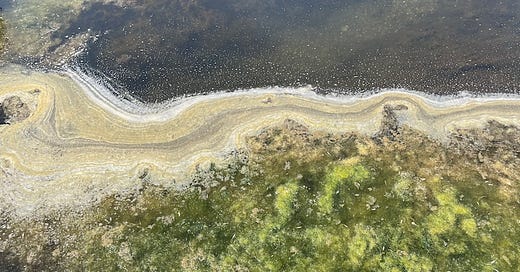


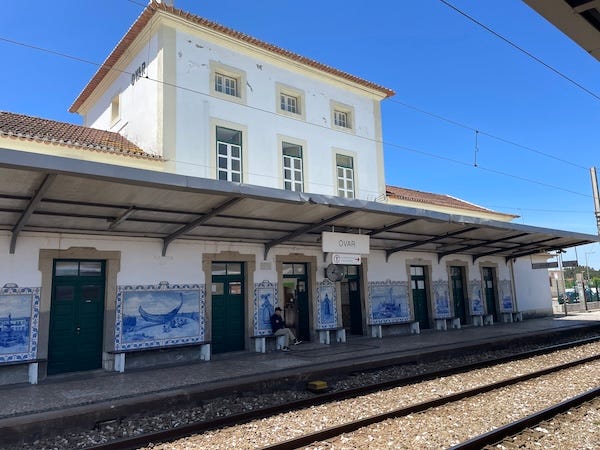

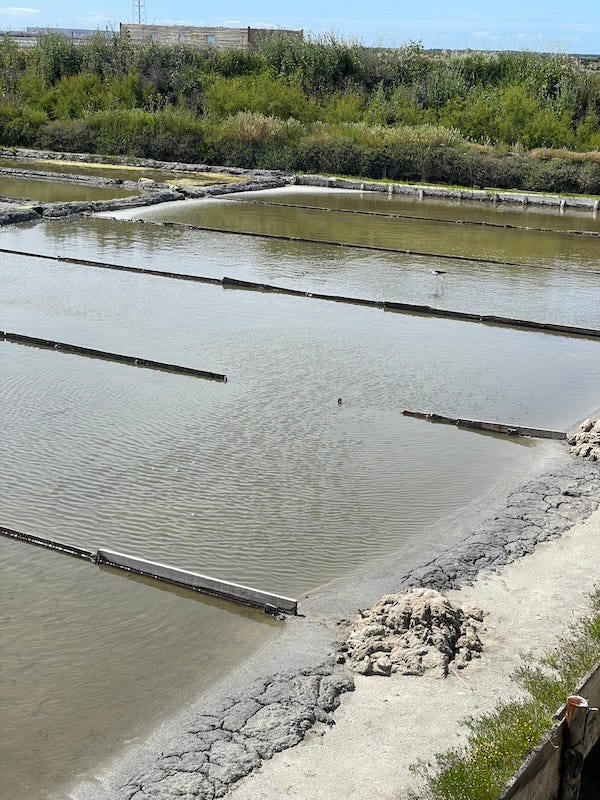
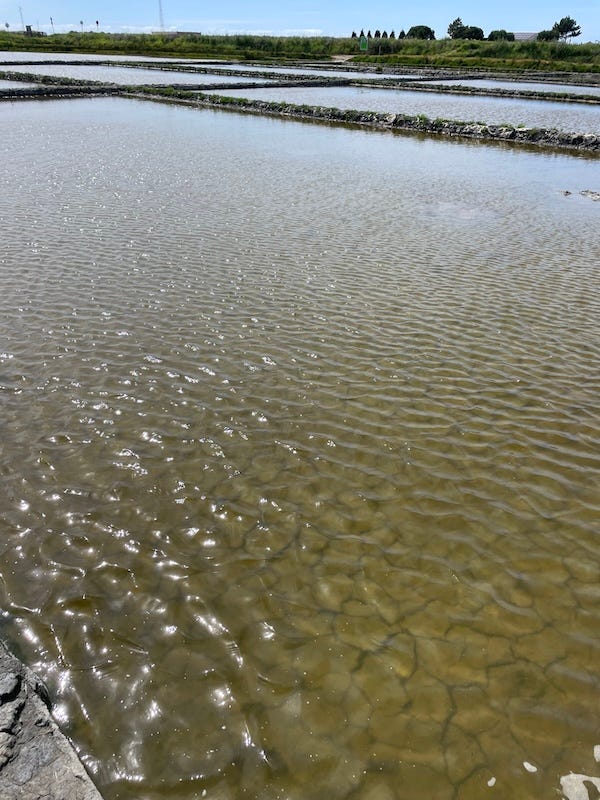
You are always the educator, Kirsten, and for that I am so grateful. In one of your books you mention the salt/salary connection: I tell that tale every time I teach fermenting! And a marvelous new-to-me word: saliculture. How many folks unconsciously pick up the shaker and spread the precious grains without even a thought of the history. Thanks for the link to the book in your online bookstore: the book Salt will be ordered! Such a nice travel experience to Portugal you shared as well.
I loved this! So interesting! I have gone down similar rabbit holes, but you definitely win!!!